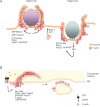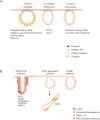Endocytosis unplugged: multiple ways to enter the cell
- PMID: 20125123
- PMCID: PMC7091825
- DOI: 10.1038/cr.2010.19
Endocytosis unplugged: multiple ways to enter the cell
Abstract
Endocytosis occurs at the cell surface and involves internalization of the plasma membrane (PM) along with its constituent membrane proteins and lipids. Endocytosis is involved in sampling of the extracellular milieu and also serves to regulate various processes initiated at the cell surface. These include nutrient uptake, signaling from cell-surface receptors, and many other processes essential for cell and tissue functioning in metazoans. It is also central to the maintenance of PM lipid and protein homeostasis. There are multiple means of internalization that operate concurrently, at the cell surface. With advancement in high-resolution visualization techniques, it is now possible to track multiple endocytic cargo at the same time, revealing a remarkable diversity of endocytic processes in a single cell. A combination of live cell imaging and efficient genetic manipulations has also aided in understanding the functional hierarchy of molecular players in these mechanisms of internalization. Here we provide an account of various endocytic routes, their mechanisms of operation and occurrence across phyla.
Figures


References
-
- Huynh KK, Kay JG, Stow JL, Grinstein S. Fusion, fission, and secretion during phagocytosis. Physiology (Bethesda) 2007;22:366–372. - PubMed
Publication types
MeSH terms
Substances
LinkOut - more resources
Full Text Sources

